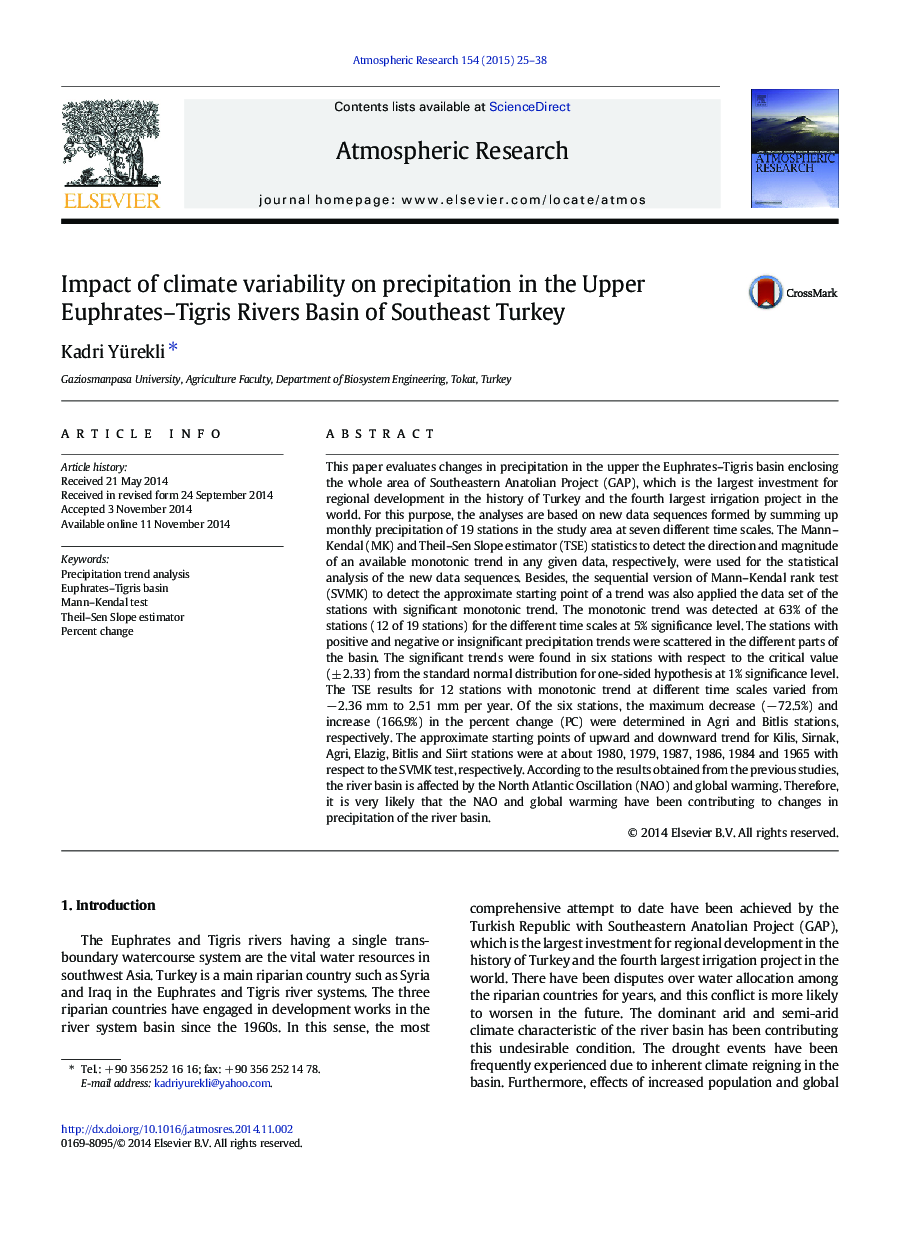| Article ID | Journal | Published Year | Pages | File Type |
|---|---|---|---|---|
| 4449845 | Atmospheric Research | 2015 | 14 Pages |
•The reasons of focusing on the area are (1) the geographic location of the upper Euphrates and Tigris rivers basin surrounded Southeastern Anatolia Project (GAP) and (2) being the poorly studied.•The probable changes in precipitation would cause failure of the sustainable water resources management program designed for the GAP region.•Changes in precipitation in the basin were analyzed by non-parametric approaches. The monotonic trend was detected at 63% of the stations considered in the basin. The majority of stations were statistically insignificant based on Mann-Kendal test even though they had negative test statistic values.•The significant trends were obtained for some stations at 1% significance level. Based on the Theil-Sen’s estimator, the maximum decreasing and increasing in percent change (PC) among the stations with significant trend at 1% significance level were determined as -72.5% and 166.9%, respectively.•The studies showed that the changes in precipitation of Turkey was affected by North Atlantic Oscillation (NAO) and global warming. It is most probably that the changes in precipitation of the basin are caused by the impact of the NAO and global warming.
This paper evaluates changes in precipitation in the upper the Euphrates–Tigris basin enclosing the whole area of Southeastern Anatolian Project (GAP), which is the largest investment for regional development in the history of Turkey and the fourth largest irrigation project in the world. For this purpose, the analyses are based on new data sequences formed by summing up monthly precipitation of 19 stations in the study area at seven different time scales. The Mann–Kendal (MK) and Theil–Sen Slope estimator (TSE) statistics to detect the direction and magnitude of an available monotonic trend in any given data, respectively, were used for the statistical analysis of the new data sequences. Besides, the sequential version of Mann–Kendal rank test (SVMK) to detect the approximate starting point of a trend was also applied the data set of the stations with significant monotonic trend. The monotonic trend was detected at 63% of the stations (12 of 19 stations) for the different time scales at 5% significance level. The stations with positive and negative or insignificant precipitation trends were scattered in the different parts of the basin. The significant trends were found in six stations with respect to the critical value (± 2.33) from the standard normal distribution for one-sided hypothesis at 1% significance level. The TSE results for 12 stations with monotonic trend at different time scales varied from − 2.36 mm to 2.51 mm per year. Of the six stations, the maximum decrease (− 72.5%) and increase (166.9%) in the percent change (PC) were determined in Agri and Bitlis stations, respectively. The approximate starting points of upward and downward trend for Kilis, Sirnak, Agri, Elazig, Bitlis and Siirt stations were at about 1980, 1979, 1987, 1986, 1984 and 1965 with respect to the SVMK test, respectively. According to the results obtained from the previous studies, the river basin is affected by the North Atlantic Oscillation (NAO) and global warming. Therefore, it is very likely that the NAO and global warming have been contributing to changes in precipitation of the river basin.
